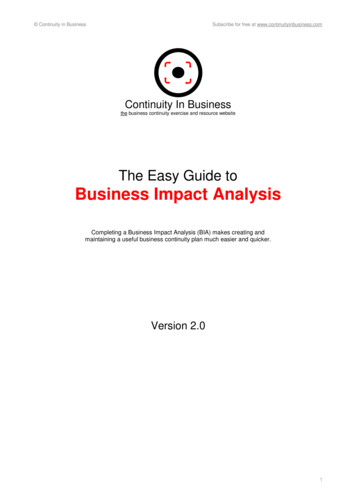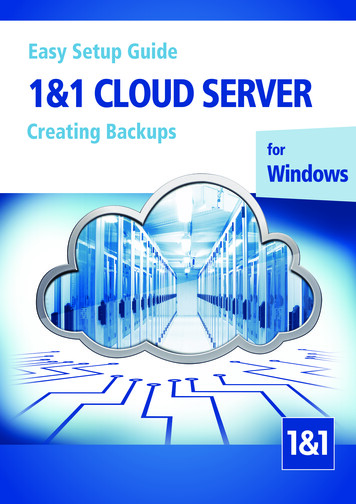
Transcription
Continuity in BusinessSubscribe for free at www.continuityinbusiness.comContinuity In Businessthe business continuity exercise and resource websiteThe Easy Guide toBusiness Impact AnalysisCompleting a Business Impact Analysis (BIA) makes creating andmaintaining a useful business continuity plan much easier and quicker.Version 2.01
Continuity in BusinessSubscribe for free at www.continuityinbusiness.comCONTENTSWelcome Notes 3APPROACH 4What is a Business Impact Analysis (BIA)? 5What You Need to Achieve 6Ultimate BIA 3-Step Checklist 7Checklist Notes 8To Speed Things Along 8When You’ve Completed the BIA 8Reviewing the BIA 8TOOLS 10BIA template 11EXAMPLE 13Delta’s Customer Service Team’s BIA 14GLOSSARY 18WHAT NEXT? 19LICENCE / DISCLAIMER 202
Continuity in BusinessSubscribe for free at www.continuityinbusiness.comWELCOME NOTESHello!Thank you for downloading the Business Impact Analysis (BIA) package, which containseverything you need to complete a BIA.Do read this pack all the way through before you begin. Like your teachers told you at school, thiswill save you time overall! Feedback suggests the example case study at the end is really useful,but it will make little sense if you‟ve not read the process.It‟s tempting to take shortcuts. The most common “shortcut” we‟ve seen in business continuity ismissing out the BIA. There are (at least) three reasons why this is always a mistake:1. It saves you time overall. It makes writing the plan faster and more efficient. Plus, in a fewmonths, when you are (or somebody else is) trying to maintain the plan, you are going tobe very thankful for the BIA.2. We‟ve seen lots of plans that look great but plan for obvious activities, rather than thecritical ones. These aren‟t the plans that will save an organisation: in fact they‟re the worstkind of plans because the company doesn‟t see the fatal flaws until it‟s too late.3. If you‟re reassuring your customers and supply chain that you‟ve taken responsibility forbusiness continuity (many companies won‟t work with those who don‟t) you will want to beable to prove you know what you‟re doing. Having a BIA to support your plan isfundamental to that.Guess what? There’s not ‘one right template’ or way to do a BIA, so you can adapt thisresource in any way you like to achieve your aim.We note how to make your BIA compliant with BS25999, the British Standard for BusinessContinuity and the basis for ISO22301. Anything required by BS25999 is written in blue text.While it‟s important to note that you must consider including everything in red, it isn’t necessary toinclude it if you have sound reason not to do so.We‟re going to make some assumptions about you though, and theyare that:a. you‟re going to make staff and people safety your very toppriority at all timesb. you‟re going to talk to people in your team and company andnot attempt this without their inputc. you‟re going to get someone senior to you to sign off the BIAbefore you write the plan (unless you‟re the boss!)TOP TIPLook out for our top tipsthroughout this pack!They’re tips and insightsgained from experience!We love feedback on what worked well for you in this pack. We also like to know what you thinkcould be better explained or improved. It helps us tweak the resources to make them even better.If you have feedback, please email us at mail@ContinuityInBusiness.com.Please visit again soon,The Team atContinuityInBusiness.com3
Continuity in BusinessSubscribe for free at www.continuityinbusiness.comApproach4
Continuity in BusinessSubscribe for free at www.continuityinbusiness.comWHAT IS A BUSINESS IMPACT ANALYSIS?Completing a Business Impact Analysis (BIA) makes creating and maintaining a useful Business ContinuityPlan (BCP) much easier and quicker.Business Continuity LifecycleIf you aren‟t already familiar with the diagram below, you soon will be!It‟s called the Business Continuity Lifecycle. It‟s taken from BS25999, which is the British Standard forBusiness Continuity, and is the basis for the new International Standard, ISO 22301. And, more importantly,it provides a completely common sense approach to creating and maintaining a business continuitymanagement system.We‟re only going to worry about one element of this lifecycle, or Step 1: Understand the Organisation. Ifyou‟re creating a plan for a single department or a group of business processes then think of thearea/process for which you are planning as the „organisation‟.Business Continuity Management Lifecyle.- Source: BS25999Yes, but what’s a BIA?In Business Continuity, the way to „understand the organisation‟ (or the area for which you are planning) is viaa Business Impact Analysis (BIA).The BIA ends up being a document that identifies and prioritises the critical activities that the businesscontinuity plan will cover. It also notes, in detail, the resources that are needed to complete each criticalactivity. This includes the people, tools, technology, workspace and anything else that is needed to completethe activity at a level that can be accepted. It will determine the resources, environment and people requiredto continue each critical activity.5
Continuity in BusinessSubscribe for free at www.continuityinbusiness.comWHAT YOU NEED TO ACHIEVEOver the page we have our ultimate checklist, and further on we have a template for you. But before we getto that, you‟ll find it helpful to know: There isn‟t a single „right‟ way to do a BIA!You should amend the BIA process and template to suit your needs!To help you do this, and navigate the resources, this is what you need to achieve from a BIA:STEP 2STEP 1UNDERSTAND THECRITICAL ACTIVITIESThis is the hardest part of the entireBusiness Continuity Planning (BCM)process!Critical activates are those that keep youorganisation afloat when business-asusual is disrupted.They often include activities that don‟timmediately spring to mind!In the process we explain in thisdocument you will list EVERY activityundertaken! Then you‟ll be shown how toscreen all but the critical ones out, so youonly plan for those that are truly critical.This is going to make sure you don’tmiss any critical activities, and – byscreening out those that aren’t reallycritical - save you loads of time later.IDENTIFYRESOURCESNEEDEDThis is the easier bit!Now you have your list of criticalactivities, you‟re going to identify theresources required to do them.This really is as simple as it sounds,but you have to be thorough!You‟re going to note every person,piece of equipment (down to chairsand pencils!), every piece oftechnology, every file to which theyneed access literally everythingthey‟ll need to do the job.STEP 3ASSESSTHREATS/RISKEvery BIA is accompanied bya Risk Assessment.If you‟re lucky, you might find arisk assessment has alreadybeen done for the activitiesyou‟re planning for. If so, youcan use that!If not, a risk assessment willneed to be included.We have a very basic section inthe BIA template if you needassistance with this too.This will make it easy for you to writethe plan later, and in the meantime,when you‟ve finished the BIA, it willhelp you make arrangements for anycontinuity arrangement you need toput in place (for example, recoverylocations or technical backupsystems).6
Continuity in BusinessSubscribe for free at www.continuityinbusiness.comULTIMATE BIA 3-STEP CHECKLIST*Notes about this checklist are on the next page!STEP 2STEP 1UNDERSTAND THECRITICAL ACTIVITIES Identify all the activities andprocesses undertaken by theorg/function/department Identify key projects being undertakenby the org/function department Identify the stakeholders for eachactivity e.g. other departments, customers,suppliers, shareholders, public Estimate the impact over time if eachof the above activities was disruptedor halted? e.g. staff safety, cost, deteriorationof service, assets, reputation,regulatory, legal and complianceissues Determine the maximum tolerableperiod of disruption for each of theabove activities e.g. 90 days, 30 days, 7 days, 1day, 4 hours, 1 hour, 1 second consider if this changes in differentseasons Identify internal and externaldependencies for each activity e.g. other departments whoneed/supply you, customers,suppliers Timings/priorities set by other plans? Identify any resilience or reciprocalarrangements already in place Make a note of where to find anymanuals or documents that supportthe above activitiesWhen you’ve done this: List activities in order of the maximumtolerable period of disruption (thosethat need to be restored first go at thetop) Decide the duration of your plan –e.g, will you plan for first 36 hours,first week, or the first 6 months?IDENTIFYRESOURCESNEEDED Determine the roles required tocomplete each activity e.g. staff, technical support,customers, suppliers, staff inother departments List the other resources requiredto complete the activity e.g. computer, access toparticular files/systems,remote access, provision ofinformation (electronic orpaper), manual workarounds,communications,client/suppliers, commssystems Determine required physicalspace How manydesks/chairs/computers,heating, cooling, meetingrooms. Do they need network access,meeting space, geographiclocation, heating/cooling,technical space, IT facilities,meeting space Is there a geographicpreference?STEP 3ASSESSTHREATS/RISKNote: BS25999 compliant BIAsare accompanied by riskassessment for critical activities.If you don’t intend to carry out arisk assessment as per yourusual company process, wesuggest you include thefollowing in your BIA instead Note previous incidents thathave disrupted yourbusiness Note previous incidents thathave disrupted neighbouringor competing businesses Consider existing riskassessments: if they don‟texist: Are there any Single Pointsof Failure (SPOFs) Make a list of realisticthreats Evaluate the likelihood ofeach threat occurring (high,medium or low) Evaluate the impact of eachthreat if it happened (high,medium or low) Note anyresilience/preventionmeasures already in place Note whether each riskshould be accepted,mitigated (i.e. measurestaken to minimise risk) orplanned forTOP TIP!Follow Step 2 only for those activities that need to berestored within your chosen planning durationThese are your critical activities!7
Continuity in BusinessSubscribe for free at www.continuityinbusiness.comCHECKLIST NOTESDo I need the checklist if I’m using the template? Understanding the checklists means you‟ll be better prepared to use the templateThe more you understand the faster you‟ll produce the BIAComplying with BS25999 Items in blue text are “required” for your BIA to comply with BS25999, the British Standard for BusinessContinuity and the basis for ISO 22301.To comply you must consider including them, though it is not mandatory to include every one of them ifthere is a sound reason not to do so Additional notes for Step 1 TOP TIPThis is the hardest part of the entire business continuity managementprocess and therefore the BIA processPAs are a great resource “List all the activities” means listing everything the department does!for helping to compile Everything means everything – all the big things, but also all theactivitylists. They often listsmall things including answering phone and email queries,vital activities others miss!attending particular meetings, providing ad hoc support to otherareas At the end of Step 1 you will note which activities are the critical activities that are going to be covered inyour plan. Critical activities are important as you don‟t need to plan for those that are not critical. They‟re theactivities that must continue during the time period covered by your plan.TO SPEED THINGS ALONG1. To speed up information gathering, consider: Organising a workshop – for quick results and teamwork Sending a structured email – if you have to cut and paste responses, include a form to make it easierfor you Planned meetings – interviews to get specific information from key people2. Delegate any areas that aren‟t of your expertise by asking others to complete your template for you3. Ensure your bosses sign off the BIA when it‟s complete: it means you can be sure the scope of thebusiness continuity plan is also signed off before you write it.WHEN YOU’VE COMPLETED THE BIAIf you’re creating a new Business Continuity Plan: Share the BIA with those who need to understand it – allow them to provide feedback to refine it Ensure everyone understands the planning will only cover critical activities that need to be restored withinthe timeframe your plan will cover Ask your bosses to sign off the BIA – this ensures you won‟t be asked to make significant changes to theBCP after you‟ve written it!If your BIA already has a Business Continuity Plan Check the critical activities and priorities in the plan match those in the BIA Check the recovery times in the BIA correspond to the times set in your plan Check any Service Level Agreements – e.g. for your IT – to check whether your recovery time matchesthe SLA (e.g. if your recovery time is 1 hour and the SLA for them to respond is 4 hours, you will need toconsider which timing needs to be changed) Share the BIA with those who need to understanding it – allow them to provide feedback to refine it8
Continuity in BusinessSubscribe for free at www.continuityinbusiness.com Ensure everyone understands the planning will only cover critical activities that need to be restored withinthe timeframe your plan will cover Ask your bosses to sign off the BIAREVIEWING THE BIAA BIA saves you time when you create a BCP. It also saves you time when you need to review the BCP.And those inheriting a BCP will be very gratefu
02.12.2011 · Business Continuity, and is the basis for the new International Standard, ISO 22301. And, more importantly, it provides a completely common sense approach to creating and maintaining a business continuity management system. We‟re only going to worry about one element of this lifecycle, or Step 1: Understand the Organisation. If











